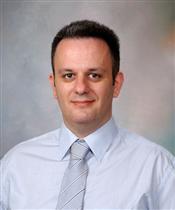Liver Delineation Using the Weighted A-Star Pathfinding Algorithm and Deep Learning On Ultrasound B-Mode Images for Cirrhosis Assessment Using Liver Biopsy as the ‘Gold Standard’
I Gatos1, P Drazinos2, S Tsantis1, P Zoumpoulis2, I Theotokas2, D Mihailidis3, G Kagadis1*, (1) University of Patras, Rion, GR, (2) Diagnostic Echotomography SA ,Athens, GR, (3) University of Pennsylvania, Philadelphia, PA
Presentations
SU-IePD-TRACK 1-2 (Sunday, 7/25/2021) 12:30 PM - 1:00 PM [Eastern Time (GMT-4)]
Purpose: To evaluate the diagnostic performance of a deep learning scheme on liver cirrhosis detection. Input data were segmented left liver lobes from ultrasound (US) B-Mode images delineated by a segmentation algorithm based on modified Weighted A-Star algorithm, on patients with Chronic Liver Disease (CLD) using liver biopsy (LB) as ‘Gold Standard’.
Methods: 69 consecutive CLD diagnosed patients (14 F0-F3 and 55 F4) underwent a regular abdomen US B-Mode and LB examination using the Metavir scale (F0-F4). A B-Mode image containing the left liver lobe was acquired and saved by an expert Radiologist performing the US examination. Then, a sophisticated segmentation algorithm based on 2D continuous wavelet transform (2D-CWT) and Weighted A-Star pathfinding was employed to delineate the liver surface boundaries from each patient’s US image. Subsequently, a binary image was produced representing the left liver’s lobe mask. A radiologist’s delineation on the same images was used as ‘Gold Standard’ for segmentation. The segmentation results were evaluated by the Jaccard’s Coefficient Index. Consequently, all mask images were fed to the GoogLeNet pre-trained deep learning scheme using LB fibrosis staging (F0-F4) as labels for fine tuning. Data was separated in two classes according to their steatosis grade: F0-F3 (Non-cirrhotic – Class 1), and F4 (Cirrhotic Class – Class 2). Mask images were separated in training (70%) and testing (30%) sets, and testing accuracies were calculated. The random image separation and GoogLeNet fine tuning processes were repeated 30 times.
Results: The segmentation algorithm achieved a mean Jaccard Coefficient performance of 0.92 using the radiologist’s delineation as reference. The deep learning scheme’s mean accuracy reached 97% for the training data and 90% for the test data respectively.
Conclusion: The results indicate that this scheme can be used as a supplementary diagnostic tool for cirrhosis detection on regular US B-Mode abdomen examination.
ePosters
Keywords
Taxonomy
IM- Ultrasound : B-mode Imaging
Contact Email



